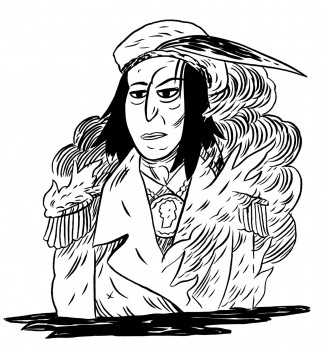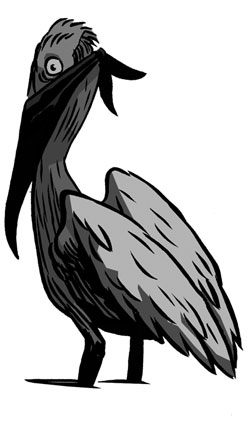by T. Mayheart Dardar
![]()
You have given him dominion over the works of your hands; you have put all things under his feet, all sheep and oxen, and also the beast of the field, the birds of the heavens, and the fish of the sea, whatever passes along the paths of the seas. –– Psalm 8:6-8, English Standard Version
“We must protect the forest for our children, grandchildren and children yet to be born. We must protect the forests for those who can’t speak for themselves such as the birds, animals, fish and trees.”
— Qwatsinas, Nuxalk Nation
Economic crashes, global climate change, resource wars, and political instability are just some of the complex challenges facing the world’s peoples in these early years of the twenty-first century. As the governments of the world profess a desire to find solutions, we need to look beyond their rhetoric to their underlying philosophies to determine the sincerity of those professions.
The theology of dominion came to our shores with the Columbian landfall in 1492. Armed with Papal decrees that subjected the lands under his footfall to his Christian King, Columbus established the pattern for devouring the peoples and resources of the land. For Indigenous Peoples the struggle over the centuries has been to reconcile this world view with their own and to define their position in a world that saw the increasing ascension of European man and the increasing subjugation of the native world.
As the original peoples of the Gulf Coast, how do we survive as Indigenous communities in the face of the decades of wholesale destruction brought about the unchecked economic exploitation that European dominion has brought? As we still deal with the aftereffects of the BP spill and the ongoing challenge of coastal land loss, on what will we build the foundation for our path to the future?

In the early years of the nineteenth century this conflict of values and identity would surface in the southeast within the Creek Nation. Inspired by the great Shawnee leader Tecumseh, the Red Sticks from the Upper Creek towns attempted to draw a line between themselves and the assimilated Lower Creek towns. The Red Sticks sought a return to traditional culture and values while the Lower towns pursued an alliance with the growing American empire. This conflict quickly escalated into a full scale civil war. The Americans, using this as a pretext, sided with those assimilated Lower towns led by William McIntosh, seeking to ensure the ascendancy of a compliant Creek government.
In 1814 the alliance of U.S. forces, Lower Creeks and pro-American Choctaws defeated the Red Stick efforts at Horseshoe Bend, but the cultural, spiritual and social conflict at the heart of the struggle continues to this very day here along the Gulf Coast.
The treaty that marked the Red Stick defeat and the land concessions granted to the United States (What was essentially a Creek civil war produced an American victor) was signed at Fort Jackson adjacent to the Hickory Grounds, the capital of the Creek Nation. This was the social and sacred heart of the people and the resting place for the bones of their ancestors. Today the site is owned by the Poarch Band of Creek Indians, the cultural if not genealogical heirs of William McIntosh. The Poarch have decided their path to the future is dependent on building a multi-million dollar hotel/casino complex atop the graves of the old ones. The theology of domination has come full circle, now infesting the hearts of indigenous societies that it failed to totally destroy.
Much was made of the meetings between tribal leaders and the now re-elected President of the United States. There was much pomp and circumstance surrounding what amounted to a half hour of face time with the President for a handful of selected native politicians. These were, for the most part, representatives of successful gaming tribes who had contributed handsomely to the cause of the Democratic Party. You can rest assured that the conversation was more about the security of tribal “economic development” than any human rights discourse. The tendency of tribal leadership is to look “north” towards the marble edifices of Washington D.C. for direction, hoping to secure the crumbs that fall from the empire’s table. It would seem that a nod or handshake from President Obama is of greater value than any substantial move towards genuine sovereignty.
For the Indigenous Peoples of the Gulf Coast, recovering from oil spills and hurricanes and facing rising tides and a shrinking land base, the choice is clear. Do we commit our precious resources to the quest for recognition by the government that has marginalized and ignored us, or do we look for another path towards the future?
If we listen, we can hear the voices of our Indigenous brothers and sisters rising with the songs of the Red Sticks. From the mountains of southern Mexico to the tundra of northwest Canada they are singing the same song. They are indeed “Idle No More,” and they are determined to lay hold of the vision of sovereignty and self-determination that the words of Tecumseh have carried across the centuries.
If we are to resist assimilation and survive as the free, self-determined people we were destined to be, we have to seek out the embers that burned at Horseshoe Bend and re-light the fires of our people. We must dedicate ourselves to our survival as a People; this is not the struggle of the individual.
Only in the mind of western man do you prepare for the apocalypse by hoarding can goods and weapons and pretending to be “John Wayne.” If we are to survive we must do so as a tribe, as a Nation. Our strength and tenacity has always been anchored in our collective ties to one another and to the land that has always sustained us.
If the Indigenous Peoples of the Gulf Coast are to survive, we must look away from the path of assimilation. We must look “south” for a fresh vision and a firm foundation for ourselves and the generations that will follow us.
“Tecumseh’s goal was to clear space on the ground for the free and unfettered existence of Onkwehonwe. His goal was not to live without white government, culture, and society, but to live against them. To do this today, Onkwehonwe warriors will need to engage the colonizer in a rebellion of truth, redefine the meaning of our renewed world in a mystic vision of struggle and justice, and force a reckoning with our regenerated and unified Onkwehonwe power through rites of resurgence. This is the warrior’s path of spiritual self-determination that has been laid before us by the ancestors and the Brothers and Sisters who share our values and vision”.
– Taiaiake Alfred, Wasáse
![]()
T. Mayheart Dardar was born in the Houma Indian settlement below Golden Meadow, Louisiana. He served for sixteen years on the United Houma Nation Tribal Council (retired in Oct. 2009). Currently he works with Bayou Healers, a community based group advocating for the needs of coastal Indigenous communities in south Louisiana. www.bayouhealers.org • houma77@yahoo.com
Share
